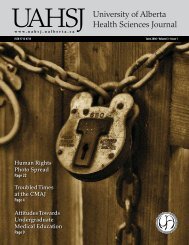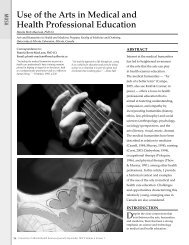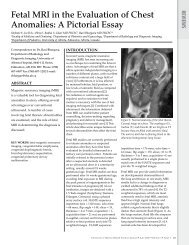MUSAContinued from page 17Asha Olmstead noticed the artistic talent<strong>of</strong> a few <strong>of</strong> her classmates and suggesteda class art show. As plans progressed,it became clear that there was interestthroughout the faculty, and the show wasexpanded to include students from all fouryears. The event allowed any medical ordentistry student to showcase their artworkfor classmates, colleagues, instructors andfriends, while also supporting a local nonpr<strong>of</strong>itorganization. “I thought the openingnight event was a great opportunity tomodel the different ways <strong>of</strong> giving to acommunity,” says Roxanne Felix, a researchconsultant and assistant adjunct pr<strong>of</strong>essorat the <strong>University</strong> <strong>of</strong> <strong>Alberta</strong> School <strong>of</strong>Public <strong>Health</strong>. 4I was really impressed with theenergy and commitment broughtby the students and faculty tothis event. I think the <strong>University</strong>needs to foster these kinds <strong>of</strong>cross-sector and innovative events.There is obviously a lot <strong>of</strong> interestand passion for looking at howhealth sciences and the arts interact– now we just need to tap intothat potential! 4Hosting the show within the context <strong>of</strong> theFaculty <strong>of</strong> Medicine and Dentistry createda space where the realms <strong>of</strong> fine art andhealth education could merge. Science andtechnology are already strongly emphasizedin health education, but students whointegrate the arts into their busy schedulesmust be self-motivated. 5 The Art Showwas a way to recognize this effort andcelebrate the results. In total, forty works <strong>of</strong>visual art were displayed, including acrylicpainting, photography, sketches, sculpture,collage, and a short film. Proceeds weredonated to the Multicultural <strong>Health</strong> BrokersCooperative to establish an “engagementfund” which helps newcomers to Canadaaccess early learning programs and healthrelatedservices for their young children. 6The weeklong exhibit was displayed in theJohn W. Scott <strong>Health</strong> <strong>Sciences</strong> Library at the<strong>University</strong> <strong>of</strong> <strong>Alberta</strong>, where the pieces couldbe viewed by students and faculty fromacross campus.The opening night event was agreat example <strong>of</strong> the “determinants<strong>of</strong> health” in two ways. Firstly,the event modelled that “giving”doesn’t have to just be within therealm <strong>of</strong> our pr<strong>of</strong>essional skills. Bysharing our talents and our gifts,you can generate many thingsfor the community – includingfundraising as that event did.Secondly, the event generateda sense <strong>of</strong> social support andcommunity in general among themedical and dentistry students.This kind <strong>of</strong> social connectednessand gathering for a cause is soimportant for all communities –including students. It providesa type <strong>of</strong> resiliency that is reallynecessary. 4My hope is that those students who struggleto find space for art will continue to create.In an environment where the function <strong>of</strong>fine art can be questioned, it becomes evenmore important to continue to supportand encourage this effort. “The linkagesbetween arts and the sciences have beenproven in research for years, but how to‘live’ this can be a bit challenging in the waythat our social structures seem to be built,”explains Felix. 4 The structure <strong>of</strong> medical anddentistry school are especially challengingin this regard. For Katie, the struggle t<strong>of</strong>ind space for art as a medical student hasbeen difficult; “The only consolation I findis knowing that [photography] will alwaysbe there, waiting, for me to tend to theprocess again.” 2As a community it is critical that wecontinue to affirm the insights andperspectives expressed through art. “Withart, it is possible to transcend the limitations<strong>of</strong> traditional scientific inquiry and to explorea more human and holistic perspective,”writes Jessie Breton, resident physicianand contributing artist at the event. 7 Thoseworking and studying in health sciencespossess a rich and valuable diversity <strong>of</strong>talent and perceptiveness that unfortunately<strong>of</strong>ten goes unrecognized and untapped. 8“Arts can contribute a lot to how wepractice and achieve success in the healthsciences – how we strive to create healthyconditions and achieve health with ourclients.” 4 For students themselves, makingart can be a powerful form <strong>of</strong> self-care; theprocess can be a way <strong>of</strong> relieving stress,learning concepts, processing emotionsand experiences, and maintaining balance.Taking that next step <strong>of</strong> sharing our artworkallows us to draw strength and inspirationfrom one another.Art, literature, drama and music,in all their many forms, areexpressions <strong>of</strong> human creativity;they reflect human joy and sorrow,and human celebration andreflection... They do not merelyhave usefulness in contributingto the development <strong>of</strong> ends otherthan themselves: they also have anintrinsic value in their own right. 9With the support <strong>of</strong> the Arts & Humanitiesin <strong>Health</strong> & Medicine (AHHM) Program atthe <strong>University</strong> <strong>of</strong> <strong>Alberta</strong>, 10 the Medical &Dental Student Art Show will run again inApril, 2012. I invite you to attend this specialevent and be a part <strong>of</strong> celebrating studentswho find the time to make art.The following excerpts are by students whowere featured at this year’s Art Show:Square TreeKatie Stringer is a medical student in theclass <strong>of</strong> 2014 at the <strong>University</strong> <strong>of</strong> <strong>Alberta</strong>.Media: Stitched PhotographsSize: 36x34inArtist’s Statement:Our society has traditionally believed inthe photograph’s ability to record the truthin a moment past. If this can still be thecase, then my unadulterated photographsrepresent the history <strong>of</strong> my personal struggleto gain control in life. For many <strong>of</strong> us thereare events in our lives that never surface tothe public or even to our closest friends. Wesmile and tidy things up but somewhere inthere is a piece <strong>of</strong> chaos that goes unspoken.On the whole, we look put-together buton closer inspection we’re people who dealwith stress, difficult relationships, illness,trauma and death. These trees touch uponthe power <strong>of</strong> human control, or a lackthere<strong>of</strong>. They are my attempt to wield andinstrument against the natural and unrulyworld. The imperfections in the piece are thetraces <strong>of</strong> humanity that reveal the truth in allthis: control over life is an illusion.Mice and MenDanny Purdy is a medical student in theclass <strong>of</strong> 2014 at the <strong>University</strong> <strong>of</strong> <strong>Alberta</strong>.Media: Pencil CrayonSize: 8.5x11inArtist’s Statement:Keeping up with one’s hobbies duringmedical school is sometimes perceived as acompromise, but is a genuinely constructiveactivity that tends to produce a greater level<strong>of</strong> satisfaction and enjoyment throughoutone’s career. The importance <strong>of</strong> ‘balance’is emphasized so heavily during medicaltraining that, at times, it seems clichéd.However, after only one year <strong>of</strong> medicalschool I recognize the importance <strong>of</strong> havinga life outside <strong>of</strong> Medicine. In my case,drawing has been a refreshing reprise fromschoolwork on many occasions. Studying sohard without any physical manifestation <strong>of</strong>the hours you’ve put in can be frustrating,and studying the same subject for daysbecomes tedious. Drawing allows one to be20<strong>University</strong> <strong>of</strong> <strong>Alberta</strong> <strong>Health</strong> <strong>Sciences</strong> <strong>Journal</strong> • April 2012 • Volume 7 • <strong>Issue</strong> 1
creative, and actually produce somethingtangible. Furthermore, I find that finishinga piece <strong>of</strong> art into which I’ve put a lot <strong>of</strong>thought and effort is an extremely fulfillingactivity.Give Me HopeVina Nguyen is a medical student in theclass <strong>of</strong> 2012 at the <strong>University</strong> <strong>of</strong> <strong>Alberta</strong>.Media: Acrylic and CrayonSize: 20x16inArtist’s Statement:In medicine, we can become caregiversholding the last source <strong>of</strong> hope for ourpatients. Unfortunately, sometimes wedo not realize that what we say or do cangreatly impact a patient’s quality <strong>of</strong> life,their perception <strong>of</strong> their illness, and theirperseverance to survive and endure difficulttimes in their life. In these situations Ifind that art can help ground and openmy perception <strong>of</strong> the world. Art also helpsme realize my biases and misconceptionsbefore I act upon them, so that I can becomea more connected healer. As healers weare exposed to a multitude <strong>of</strong> experiences,from loss and grief, to anxiety and joy. Artcan help us internalize all these emotionalexperiences so that we may learn and growfrom them. In this way, I believe that artnot only nurtures the heart and soul, but itmay also nurture the mind by encouragingcreative, open thinking. Art for me is animportant part <strong>of</strong> medicine: it satiates myneed for creativity, ensures there is balancein my life, and exercises my mind to stayopen and understanding.References1. Lee, J. & Graham, A. (2001). Studentsperception <strong>of</strong> medical school stress andtheir evaluation <strong>of</strong> a wellness elective,Medical Education, 35 (7): 652–659.2. Stringer, K. Personal Interview. 10 August2011.3. Root-Bernstein, RS. (1996). The sciencesand arts share a common creativeaesthetic. The Elusive Synthesis: Aestheticsand Science. Dordrecht: Kluwer AcademicPublishers: 49–82.4. Felix, R. Personal Interview. 12 August2011.5. Brett-MacLean, P. (2007) Use <strong>of</strong> the Arts inMedical an <strong>Health</strong> Pr<strong>of</strong>essional Education.<strong>University</strong> <strong>of</strong> <strong>Alberta</strong> <strong>Health</strong> <strong>Sciences</strong><strong>Journal</strong>, 4 (1): 26-29.6. Multicultural <strong>Health</strong> Brokers Co-operative,www.mchb.org7. Breton, J. (2011). Birth marks: An artisticexploration into the medical, personal,societal, and historical dimensions <strong>of</strong>postpartum depression (PPD) througha collection <strong>of</strong> sketches, collages, andjournalling. <strong>University</strong> <strong>of</strong> <strong>Alberta</strong> <strong>Health</strong><strong>Sciences</strong> <strong>Journal</strong>, 6 (1): 13-14.8. Brett-MacLean, P., Casavant, M., &Kennedy, D.Y. (2010). Artists AmongUs: Happiness as an element in healthpr<strong>of</strong>essionals’ artist statements. Atrium:The Report <strong>of</strong> the Northwestern MedicalHumanities and Bioethics Program, 8: 18-20.9. Macnaughton, J. (2000). The humanitiesin medical education: context, outcomesand structures. J Med Ethics: MedicalHumanities, 26: 23–30.10. Art & Humanities in <strong>Health</strong> & Medicine(AHHM), www.med.ualberta.ca/Home/Education/ ArtsHumanitiesMUSAOn the value <strong>of</strong> narrative reflective practice: A personal reflectionDebbi Andrews, MDDivisional Director and Associate Pr<strong>of</strong>essor, Division <strong>of</strong> Developmental Pediatrics,Faculty <strong>of</strong> Medicine and Dentistry, <strong>University</strong> <strong>of</strong> <strong>Alberta</strong>, Edmonton, CanadaCorrespondence to Dr. Debbi Andrews: Email: andrewsd@ualberta.caIn December 2010, I attended a workshopon Narrative Reflective Practice (NRP)hosted by the <strong>Health</strong> <strong>Sciences</strong> Education andResearch Commons (HSERC) and Centrefor Teaching and Learning (CTL) at the<strong>University</strong> <strong>of</strong> <strong>Alberta</strong>. The workshop facilitator,Dr. Hedy Wald from Brown <strong>University</strong>,asked participants to prepare and share shortdescriptions <strong>of</strong> their own experiences usingnarrative writing exercises with students.As I started to work on the customary 3-5Powerpoint slides, I realised that there was verylittle reflection involved in what I was proposingto present, just a bone-dry list <strong>of</strong> what was done.This didn’t capture the experience <strong>of</strong> facilitatingan NRP session, and I doubted it would sparkany reflection in the workshop group. I deletedthe slides and took out a pen. The followingis my own narrative reflection that I read tothe group.I am no orator, but I am a writer. I choosetoday to talk about my own experience inteaching and facilitating narrative practice inthe form <strong>of</strong> a read narrative.For the past two years I have facilitatedsmall group narrative reflective practicesessions for first year medical students aspart <strong>of</strong> their Patient-Centred Care course. 1These sessions are part <strong>of</strong> an initiative toinsert exercises in reflection at key pointsduring medical school and residency at the<strong>University</strong> <strong>of</strong> <strong>Alberta</strong>. The themes presentedin the first year include pr<strong>of</strong>essional identity,pr<strong>of</strong>essionalism and biomedical ethics. Laterthe students have opportunities to reflect ontheir encounters with patients and staff inclinics and on the hospital wards. I confessthat I was initially drawn to participatingin these sessions for somewhat selfishreasons—I am a writer and wanted a way tointegrate my own writing background withteaching. Now, because <strong>of</strong> two very differentexperiences in facilitating these groupsfrom last year to this one, I am even morecommitted to the importance <strong>of</strong> reflectivewriting in medical training. I have a betterunderstanding <strong>of</strong> what the act <strong>of</strong> writing canmean for achieving understanding. Let meexplain what I mean.The students’ assignment was to write, thenshare aloud, a one page narrative on thetopic <strong>of</strong> medical identity—what it meansto become a doctor, both as a generalprocess and how this might apply to themas individuals. For each session the writingprompt was a film that was viewed by theentire first year medical class, followed bya faculty panel who reflected on some <strong>of</strong>the issues from the film and an interactivequestion and answer session. Afterwards,the students wrote their own brief reflectiveresponses to the film, and then, two dayslater they shared those reflections infacilitated small groups.<strong>University</strong> <strong>of</strong> <strong>Alberta</strong> <strong>Health</strong> <strong>Sciences</strong> <strong>Journal</strong> • April 2012 • Volume 7 • <strong>Issue</strong> 1 21






